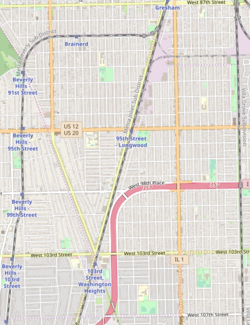Washington Heights | |
|---|---|
| Community Area 73 – Washington Heights | |
 Carter G. Woodson Regional Library | |
 Location in Chicago | |
 Street map of Washington Heights and its immediate surroundings, from OpenStreetMap | |
| Coordinates: 41°42.23′N 87°39.22′W / 41.70383°N 87.65367°W | |
| Country | United States |
| State | Illinois |
| County | Cook |
| City | Chicago |
| Neighborhoods | list
|
| Area | |
| • Total | 2.1425 sq mi (5.5490 km2) |
| Population (2020) | |
| • Total | 25,065 |
| • Density | 12,000/sq mi (4,500/km2) |
| Demographics (2017) | |
| • White | 0.7 % |
| • Black | 95.8 % |
| • Hispanic | 0.8 % |
| • Other | 2.7 % |
| Time zone | UTC-6 (CST) |
| • Summer (DST) | UTC-5 (CDT) |
| ZIP Codes | parts of 60620, 60628 and 60643 |
Washington Heights is the 73rd of Chicago's 77 community areas. Located 12 miles (19 km) from the Loop, it is on the city's far south side. Washington Heights is considered part of the Blue Island Ridge, along with the nearby community areas of Beverly, Morgan Park and Mount Greenwood, and the village of Blue Island. It contains a neighborhood also known as Washington Heights, as well as the neighborhoods of Brainerd and Fernwood. As of 2017[update], Washington Heights had 27,453 inhabitants.
Named for the heights which are now part of the adjacent Beverly, the area was settled in the late 19th century at the intersection of two railroad lines. It was incorporated as a village in 1874, and was annexed by Chicago in 1890. During most of the 20th century, Washington Heights was primarily inhabited by Irish, Germans and Swedes; after late-20th-century white flight, it has been mainly inhabited by African-Americans. The area largely retained its middle-class character during its racial transition, declining somewhat in recent years.
Historically influenced by transit, Washington Heights includes the original site of the former Chicago Bridge & Iron Company. The Brainerd Bungalow Historic District and the Carter G. Woodson Regional Library, home of the largest collection of African-American history in the midwestern United States, are in the area.